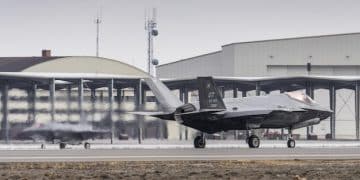US Strategies to Combat Terrorism in 2025

The United States must implement a multi-faceted approach combining enhanced intelligence, robust international partnerships, technological advancements, and a focus on root causes to effectively combat the evolving threat of international terrorism by 2025.
The global landscape of terrorism is in constant flux, presenting complex challenges that demand innovative and adaptable responses. By 2025, the United States faces an imperative to refine and broaden its counter-terrorism efforts. Understanding what strategies can the US use to combat the growing threat of international terrorism in 2025 is crucial for safeguarding national security and promoting global stability.
Adapting Intelligence Gathering and Analysis
The efficacy of counter-terrorism operations hinges significantly on superior intelligence. As terrorist organizations become more decentralized and technologically savvy, traditional methods of information gathering must evolve. This necessitates not only enhancing human intelligence but also leveraging advanced digital forensics and big data analytics. The goal is to predict threats before they materialize and unravel complex networks with greater precision.
Proactive Intelligence Collection
Proactive intelligence involves anticipating threats rather than merely reacting to them. This means investing in specialized training for intelligence operatives to understand emerging terrorist ideologies, financial flows, and communication patterns. It also requires the deployment of sophisticated surveillance technologies that can operate in diverse and challenging environments, respecting privacy concerns while maximizing data collection.
- Enhanced human intelligence (HUMINT) networks in high-risk regions.
- Advanced open-source intelligence (OSINT) analysis of social media and dark web activities.
- Predictive analytics leveraging artificial intelligence to identify anomalous patterns.
Integrated Data Analysis Platforms
Fragmented intelligence leads to blind spots. Developing integrated data analysis platforms that can seamlessly combine information from various intelligence agencies, both domestic and international, is paramount. Such platforms would allow for a more holistic view of threats, improving pattern recognition and the identification of potential collaborators or facilitators across different groups. This integration should prioritize secure information sharing protocols.
The analytical process must also incorporate nuanced cultural and sociological understanding to interpret intelligence effectively. Misinterpretations can lead to misguided policy decisions. Therefore, intelligence agencies should foster diverse teams with expertise in various geopolitical contexts, linguistic skills, and religious studies. This interdisciplinary approach ensures that intelligence assessments are as comprehensive and accurate as possible, minimizing the risk of misjudgment in critical security matters.
The continuous refinement of intelligence methodologies is not a static endeavor but an ongoing process of adaptation and innovation. As terrorist groups leverage new technologies and tactics, so too must the intelligence community. This flexible and responsive posture is essential for maintaining an edge in the perpetual struggle against international terrorism, ensuring that the US remains vigilant and effective in its defense strategies.
Strengthening International Partnerships and Alliances
No single nation can combat international terrorism alone. The global nature of this threat demands a collaborative and unified response. Strengthening partnerships, sharing intelligence, and coordinating counter-terrorism efforts with allies are indispensable components of a robust strategy. These alliances extend beyond traditional military cooperation to encompass law enforcement, financial intelligence units, and even civilian capacity-building initiatives.
Enhanced Bilateral and Multilateral Cooperation
Building strong bilateral relationships with key nations in vulnerable regions allows for direct, context-specific counter-terrorism efforts. Multilateral frameworks, such as those through the United Nations, NATO, and other regional bodies, provide broader platforms for policy coordination, intelligence sharing, and joint operations. These forums facilitate the development of common strategies and the pooling of resources.
- Joint counter-terrorism training exercises with allied forces.
- Establishment of shared intelligence fusion centers.
- Harmonization of legal frameworks to prosecute terrorists.
Capacity Building and Foreign Assistance
Many nations lack the resources or expertise to effectively counter domestic and international terrorist threats. The US can play a pivotal role in providing foreign assistance for capacity building in these countries. This includes training local security forces, enhancing border control capabilities, and providing technological support for intelligence gathering and analysis. Such assistance not only helps these nations but also creates a more secure global environment for the US.
Investing in the socio-economic development of vulnerable communities worldwide can also serve as a long-term counter-terrorism measure. Addressing the root causes of radicalization, such as poverty, lack of educational opportunities, and political grievances, can significantly diminish the appeal of extremist ideologies. This holistic approach, combining security measures with developmental aid, tackles the problem on multiple fronts, fostering stability and resilience against extremist narratives.
Ultimately, robust international partnerships are about establishing a network of shared responsibility and mutual support. When nations work together, leveraging their unique strengths and insights, the collective ability to detect, deter, and defeat terrorist threats is vastly amplified. This cooperative framework forms the bedrock of an effective global counter-terrorism strategy for 2025 and beyond.
Leveraging Technological Advancements
Technology is a double-edged sword in the fight against terrorism. While it can be exploited by extremist groups for communication, recruitment, and planning, it also presents unparalleled opportunities for counter-terrorism efforts. The US must continually invest in and adapt cutting-edge technologies to maintain a strategic advantage. This includes artificial intelligence, robust cybersecurity measures, and advanced surveillance tools.
Artificial Intelligence and Machine Learning
AI and machine learning can revolutionize intelligence analysis by sifting through vast quantities of data at speeds impossible for humans. These technologies can identify patterns, anomalies, and connections that might otherwise go unnoticed, helping to predict terrorist activities. They can be used to track financial transactions, analyze online propaganda, and even detect subtle changes in behavior that could indicate radicalization.
- Automated analysis of terrorist communication networks.
- Predictive modeling for identifying high-risk individuals or groups.
- Deepfake detection to combat disinformation campaigns.
Cybersecurity and Critical Infrastructure Protection
Terrorist groups increasingly target critical infrastructure and engage in cyber warfare. Bolstering national cybersecurity defenses is paramount to protect essential services such as power grids, financial systems, and communication networks from disruptive attacks. This involves continuous monitoring, rapid incident response protocols, and public-private sector partnerships to share threat intelligence and best practices.

The development and deployment of advanced surveillance technologies, such as facial recognition, drone technology, and biometric identification, can enhance border security and public safety. However, their implementation must be balanced with strict ethical guidelines and privacy protections to maintain public trust and avoid unintended consequences. The careful calibration of technological capabilities with civil liberties is crucial for successful integration.
The rapid pace of technological change means that counter-terrorism strategies must be agile and forward-looking. What is cutting-edge today may be obsolete tomorrow. Therefore, continuous research and development, coupled with robust training programs for counter-terrorism personnel on these new tools, are essential components of staying ahead of evolving threats. Embracing technological innovation responsibly is key to future security efforts.
Disrupting Terrorist Financing and Logistics
Money is the lifeblood of terrorist organizations, enabling them to recruit, train, plan attacks, and acquire weapons. A critical strategy to combat international terrorism involves aggressively targeting and disrupting their financial networks and logistical supply chains. This requires a coordinated effort across financial institutions, law enforcement agencies, and international partners to freeze assets, interdict illicit transactions, and expose funding mechanisms.
Tracking and Seizing Terrorist Assets
Financial intelligence units must enhance their capabilities to trace complex financial flows, including those involving cryptocurrencies and informal transfer systems. Implementing stringent anti-money laundering (AML) and counter-financing of terrorism (CFT) regulations is essential. Collaboration with international bodies like the Financial Action Task Force (FATF) helps to establish global standards and coordinate asset freezes.
- Expanded use of blockchain analytics to track cryptocurrency transactions.
- Increased penalties for financial institutions complicit in illicit transfers.
- International cooperation on asset recovery and forfeiture.
Targeting Logistical Support Networks
Terrorist groups rely on logistical networks for movement of personnel, weapons, and other resources. This includes everything from human trafficking and smuggling routes to procurement of bomb-making materials. Disrupting these networks requires a multi-pronged approach involving border security, customs enforcement, and intelligence sharing to interdict illicit shipments and identify facilitators.
Developing a deeper understanding of the informal value transfer systems, such as Hawala, used by many terrorist groups, is also crucial. While these systems serve legitimate purposes, their lack of transparency makes them susceptible to abuse. Counter-terrorism efforts need to find ways to monitor these systems without disrupting legitimate economic activity, relying on intelligence and partnerships with local authorities.
Furthermore, sanctions against individuals and entities involved in terrorist financing and logistics serve as powerful deterrents. These sanctions can isolate key players, deny them access to financial systems, and prevent them from operating freely. The continuous identification and listing of such targets, supported by robust intelligence, reinforces the commitment to financial disruption as a primary counter-terrorism tool.
Countering Radicalization and Extremist Propaganda
The ideological battle against terrorism is as crucial as the kinetic one. Terrorist organizations thrive by recruiting individuals who become radicalized by extremist narratives. A comprehensive strategy must include robust programs to counter radicalization, both online and offline, and effectively challenge the allure of extremist propaganda by promoting alternative, positive narratives.
Strategic Communication and Counter-Narratives
Extremist groups are highly adept at using social media and other platforms to disseminate their propaganda. The US must develop and promote compelling counter-narratives that expose the hypocrisy, violence, and futility of extremist ideologies. This involves partnering with community leaders, former extremists, and credible voices to amplify messages of peace, tolerance, and opportunity.
- Funding grassroots initiatives that promote community resilience.
- Supporting educational programs that foster critical media literacy.
- Developing digital campaigns to debunk extremist myths.
Rehabilitation and Deradicalization Programs
For individuals who have been radicalized or are at risk, effective rehabilitation and deradicalization programs are essential. These programs often involve psychological support, vocational training, and social reintegration initiatives designed to help individuals disengage from extremist groups and return to constructive lives. Prevention programs are equally important for at-risk youth.

Collaboration with technology companies is vital in combating online radicalization. This means working with social media platforms to identify and remove extremist content responsibly and swiftly, while respecting free speech principles. It also involves exploring technological solutions, such as AI-driven content moderation, to scale these efforts effectively across vast online spaces.
Ultimately, countering radicalization is a long-term endeavor that requires patience, understanding, and a nuanced approach. It’s about winning hearts and minds by demonstrating that there are viable, peaceful alternatives to violence and extremism. Investing in social cohesion, economic opportunity, and inclusive governance strengthens communities against the appeal of radical ideologies, thereby diminishing the pool of potential recruits for terrorist organizations.
Enhancing Homeland Security and Preparedness
While international efforts aim to interdict threats before they reach US shores, robust homeland security and preparedness measures remain essential. A multi-layered defense strategy involves strengthening border security, enhancing aviation and maritime security, and preparing communities to respond effectively to potential attacks. This layered approach minimizes vulnerabilities and maximizes responsiveness.
Advanced Border Security and Screening
Securing national borders against the infiltration of terrorists and illicit materials is a continuous challenge. This involves deploying advanced screening technologies at ports of entry, increasing surveillance along land borders, and enhancing intelligence sharing between border agencies and federal partners. Biometric data and predictive analytics can further improve screening efficiency.
- Increased deployment of advanced scanning technologies at airports and seaports.
- Cross-agency collaboration among Customs and Border Protection, TSA, and FBI.
- Real-time intelligence sharing with international border agencies.
Community Engagement and Public Awareness
Homeland security is not solely the responsibility of government agencies; it also relies on informed and prepared communities. Public awareness campaigns can educate citizens on how to recognize suspicious activity and report it to authorities. Community engagement programs foster trust between law enforcement and diverse populations, encouraging cooperation and information sharing.
Regular drills and exercises, involving both emergency responders and the public, are critical for ensuring preparedness for various types of terrorist attacks, including chemical, biological, radiological, and nuclear (CBRN) threats. These exercises refine command and control structures, test communication systems, and help to identify areas for improvement in response protocols, making communities more resilient.
Furthermore, protecting soft targets—public spaces, mass transit systems, and educational institutions—requires a combination of physical security enhancements, surveillance cameras, and trained security personnel. Collaboration between local law enforcement and private sector entities that manage these spaces is key to developing tailored security plans and rapidly responding to incidents. A proactive and adaptive homeland security posture ensures that the nation is ready to face evolving threats.
| Key Area | Strategic Focus |
|---|---|
| 📊 Intelligence | Enhance data analytics and HUMINT for predictive threat detection. |
| 🤝 Partnerships | Strengthen global alliances and build foreign capacity. |
| 🧪 Technology | Leverage AI, cybersecurity, and advanced surveillance responsibly. |
| 🛑 Disruption | Target financial flows and logistics of terrorist networks. |
Frequently Asked Questions
Technological advancements are crucial. AI and machine learning enhance intelligence analysis, speeding up threat detection. Advanced cybersecurity protects critical infrastructure from cyberattacks. However, these tools must be implemented ethically, balancing security needs with privacy rights to maintain public trust and avoid unintended consequences in their extensive application.
International partnerships are fundamental. Terrorism is a global threat, requiring coordinated responses. Strong alliances facilitate intelligence sharing, joint operations, and capacity building in vulnerable nations. This collaborative approach enhances the collective ability to detect, deter, and defeat terrorist networks, creating a more secure global environment for all involved countries and populations.
Disrupting terrorist financing is critical because money fuels their operations. By targeting financial networks, the US aims to freeze assets, interdict illicit transactions, and expose funding mechanisms. This starves organizations of resources needed for recruitment, training, and attack planning, thereby significantly hindering their operational capabilities and overall effectiveness worldwide.
Countering radicalization involves strategic communication to promote compelling counter-narratives that expose the flaws of extremism. This includes partnering with community leaders and former extremists. Additionally, supporting rehabilitation and deradicalization programs helps individuals disengage from extremist ideologies, fostering societal resilience against recruitment efforts by various organizations globally.
Homeland security measures include advanced border screening technologies and increased surveillance at entry points. Community engagement and public awareness campaigns are vital for recognizing and reporting suspicious activities. Regular drills and exercises ensure emergency preparedness, while protecting soft targets like public spaces is crucial for minimizing vulnerabilities and enhancing overall national resilience.
Conclusion
The battle against international terrorism is a dynamic and enduring challenge that demands foresight, flexibility, and sustained commitment. For the United States to effectively combat this growing threat by 2025, a multifaceted and integrated approach is indispensable. This means continuously refining intelligence capabilities, fostering robust international partnerships, leveraging cutting-edge technology responsibly, aggressively disrupting terrorist financing, and proactively countering radicalization through persuasive narratives. Furthermore, maintaining a strong and adaptable homeland security posture, coupled with vigilant community engagement, forms the final layer of defense. The synergy of these strategies, executed with precision and ethical consideration, will be paramount in safeguarding national security and contributing to global stability in the face of evolving extremist threats.





